Celebrations and Ruins in Huánuco Pampa

Visiting wonderful archaeological sites along the way has been one of the many joys of traveling through the Americas. Occasionally it requires a good hard hike to get there. We had no intention of visiting the Peruvian ruins of Huánuco Pampa (also known as Huánuco Viejo) but while we were riding through La Unión, the local pride in this beloved site got our curiosity going. We could have taken a 5am bus up to the 3700 meter plateau but we didn't want to get up that early, we needed some exercise on our day off from riding, and it's far more direct to walk, so we headed up the narrow canyon to visit old Inca Ruin, Huánuco Pampa.
I was very impressed on how treacherous this route was but it was a major walking thoroughfare for the local people. Slippery rubble lined the route the first first few hundred meters. It seemed not to bother the locals as they knew this was the shortest route from the high pampa flat plateau down to the town of La Unión 700 meters below. It was a beautiful sunny morning and just the right temperature for this adventure. We greeting everyone as we passed by. "buenos dias!" to the shepherds and the cowboys leading the horses and donkeys laden with recent harvested goods. "Hola" to the school children riding donkeys or hiking down with plastic backpacks on their tiny backs. "Como esta" to the woman riding the horse 6 hours from her farm high in the mountains. The most amazing was the very ancient woman who trekked this arduous route with her cane. read more here... lee mas aquí... »
We are not the only riders! Check this out - Dominic Gill
We are not certainly the only ones who are riding or have ridden their bicycle from the most northern part of North America to the most southern tip of South America. When we started this trip over two years ago we met a young man, Dominic Gill, in Whitehorse, who was riding a tandem by himself so he could pick up riders along the way. He recently finished this incredible journey, in the middle of the frozen Patagonian winter! (By the way: We decided a long time ago that if we're running late to get to Patagonia before the winter sets in we'll take a bus to speed things up!)
Here is a short interview with him on CNN: read more here... lee mas aquí... »
Riding down to Huánuco, A rough day
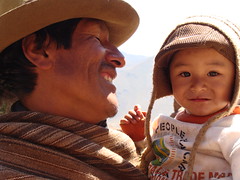
Note: We've posted our favorite pictures from northern Peru here or as a slideshow.
Yesterday we rode about 45 miles up to 4000 meters (13,120 feet) and then down to 1900 meters (6232 feet) on a nasty, loose, difficult dirt road. Randy crashed on the downhill. He scraped up his arm and hip and bruised a rib. I was behind him and when I came up to him he was down on the ground holding his hip, right on an edge of the road 5 feet from a big, big drop. He was bruised up yesterday but feeling better today. Seeing him lying there scared me. By his position, I thought he broke a hip or a leg. All the rest of the day I was upset.
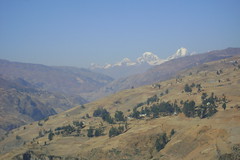
And Randy got his favorite bike tool (a Topeak Alien multi-tool) taken or lost, probably in the midst of a crowd at a fiesta in a little tiny pueblo at the top of the pass. Everybody was pressing around us. We don't know for sure that somebody took it then, but it was gone right then. He had used it earlier that morning. We have to find a replacement for some of those tools now.
And Randy lost his sunglasses somewhere, so was riding all day with no protection against the immense dust of the road.
The dogs, who are always very protective of their territory, seem much more aggressive then usual. read more here... lee mas aquí... »
Beautiful Riding and The Rich Culture of the Peruvian Andes

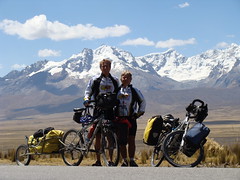
We've just had the delight of riding right up into the Andes, over the highest pass of our trip, and over hundreds of kilometers of both paved and dirt road. It has to be some of the best bike touring we've ever done. And some parts of it were probably as hard as we've ever done.
In Huaraz, in the Cordillera Blanca, we looked out of our hotel window at the amazing peaks of the tallest mountain range outside the Himalayas. Huaraz is at about 3000 meters, or 10,000 feet. But from there we began to climb gradually to a pass at 4300 meters, then down a bit, then up to the biggest pass of the trip, at 4700 meters (15,400 feet). It was all incredibly beautiful.
But the best part all along the way was the people we met. There were shy families along the way, tending their sheep while knitting or spinning wool into yarn. One woman let Nancy hold her most prized lamb. We ran into celebrations in three different villages. They roped us into the dancing and the eating and the drinking. It was a delight. We stayed the night camped out with a Spaniard who is "getting away from it all" with a flourish - he and a friend showed Nancy how to pan for gold - and she found a little flake of gold in the Rio Maranon! Now she's rich and can afford the rest of the trip.
In Huánuco Pampa (Huánuco Viejo) we saw not only ancient Inca ruins but an amazing cultural competition, with planting and slingshot competitions along with potato peeling and spinning and rope braiding. read more here... lee mas aquí... »
Finance and Money Management On The Road
Lots of people ask us how we get money while travelling, and whether we carry a lot of cash, etc. Here's an attempt to answer your questions.
Money is obviously a big issue. You want to have enough, but not so much that you might lose it all at once.
These days it's just tremendously easy to get money from ATMs. The only exception to this that I know of is Cuba, and that's a whole different story. But everywhere we've been we're just a few days from an ATM. There are times the ATM doesn't work or won't dispense the amount of money we want, but the ATM has completely put away the use of travellers' checks (a waste of time and money) and the need to carry large amounts of dollars. (FYI: There are actually a number of machines in Latin America where you can withdraw dollars in addition to the local currency.)
Some tips:
- Use a debit card. It costs LOTS of fees to do a cash advance against a credit card.
- Find out from your bank how much it will cost to use your card at an ATM in Latin America. Some banks charge 2% of the advance and perhaps an additional transaction fee. Our bank (Fidelity) charges nothing. (The ATMS/Banks themselves sometimes charge a fee, but usually not. Sometimes there's a US$1.00 fee tacked on the statement. Sometimes there's a fee added at the ATM. Often there's no charge.)
- Carry at least two different debit cards, from different banks. Carry them in different places. Sometimes your bank will (for no reason or for a good reason) just stop letting you get money off of a card.
Gringo is not a bad word, and other misunderstandings
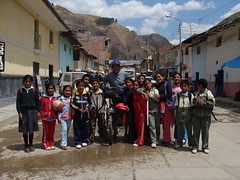
Everywhere we go in Peru the children cry out "Gringo!" It has happened in lots of countries, but they're SO enthusiastic about it here. Some cyclists misunderstand this cultural phenomenon and think that "gringo" has a negative context (or only applies to North Americans). It's just not true. Gringo is just a regular descriptive term, and everywhere we've been it just describes people who talk funny, wear funny clothes, have a funny walk, and probably have money. That even includes people from Chile, and can include kids from the city who dress like gringos.
Some people have heard the story that "gringo" was something said in Mexico during the various US invasions, and it referred to the green uniforms of the invading US troops, and they were saying "Green Go Home" or something. Well, it might be true (nobody knows) but is has nothing to do with what "gringo" means today. Gringo just refers to any north-American, European, Japanese, or most any foreigner who looks or talks funny. It's not an insult. Of course, like any descriptive term it could be used as an insult.
Another little Spanish word that confuses cyclists: Adios. You may have been taught that "Adios" means "goodbye", but in Mexico and Central America it means "Hi and Bye", kind of like I think "Aloha" means in Hawaii. read more here... lee mas aquí... »
Bike Maintenance In Latin America
People sometimes ask us what kind of bike we recommend, and how we manage bike maintenance. Here are some thoughts.
Ride a bike that's maintainable. In Latin America, that means a 26" mountain-bike style bike with standard components (V-Brakes or cantilever brakes, not disk brakes). You can buy 26" tires and tubes in even a small town, and you can find a mechanic who will have at least some tools for working on your bike. In a medium-sized town, you can get a rim and maybe spokes. If you have a 700cm wheel, you may have to send away to the nearest capital city and wait for a few days to get some of these things. Some people with difficult-to-obtain parts have spent lots of money on international shipping (and then on customs duties) and have waited ages to get going again when they've had a failure.
Ride a bike that's strong. It's better to be heavy than fragile. Get 36-spoke wheels (we're committed to this after a long failure of a 32-spoke back wheel in Canada. We haven't had a broken spoke since we switched to 36 spoke wheels). Get straight-gauge, strong spokes.
Carry a few spare parts. You can't carry everything. We always have tubes and patch kits, some spokes and the tools to replace them. Many people carry a spare tire. We don't, at least until now.
Keep the bike clean. We think that a bike that's clean doesn't wear as fast, especially the drive train. About every month, more in dusty dirt roads, less on clean pavement, we take our bikes and clean them and completely clean the chain and drivetrain. read more here... lee mas aquí... »
Camping Versus Hotels in Latin America
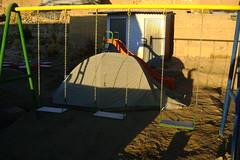
When other cyclists told us we would probably spend a lot of nights in hotels in Latin America, we kind of scoffed at them. As seasoned bike tourists, having camped all over the US and Canada, we figured we'd be camping more than most.
But we have been staying more than 80% of the time in hotels in Latin America (although that number is declining as we get farther south). People ask about this, so we thought we'd tell you why.
Camping in Latin America is different from camping in the US and Canada. There are no (or almost no) "official" campgrounds. It's really rare to see anything like that, and when you do, it's often more expensive than a hotel. And there is almost no "unclaimed" land, like in the western US or Canada. In the US and Canada, if you see a quiet place, you can just set your tent up there (if you're discreet) and nobody will ever know or bother you. In Latin America, almost everything is "owned". One time we set up discreetly behind a horse barn in a Mexican pasture right at dusk. Since we had run out of options, we just set up. We were immediately discovered. Some kids came and checked on us right away. Nobody bothered us, but we were not succeeding at hiding out. read more here... lee mas aquí... »
